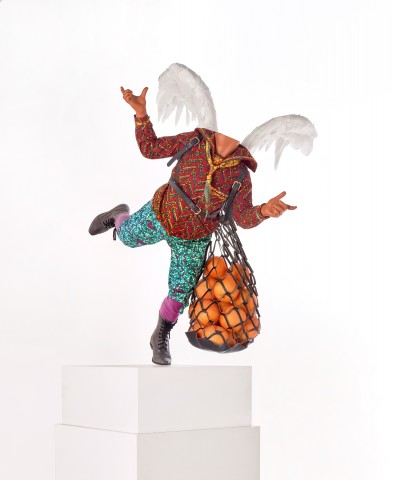FOOD FAERIE, 2010
YINKA SHONIBARE CBE
fiberglass mannequin, Dutch wax printed cotton, leather, artificial fruit and goose feathers
111.0 x 122.0 x 85.0 cm
Anna Schwartz Gallery, Melbourne
Shannon Bennett, Melbourne, acquired from the above in 2010
Food Faerie, 2010, 111.8 x 127.0 x 66.0 cm, in the collection of 21c Museum Hotel, Lexington, Kentucky, USA
Food Faerie, 2010, 118.0 x 120.0 x 96.8 cm, in the collection of The Ethelbert Cooper Gallery of African & African American Art, Harvard University, Massachusetts, USA
Food Faerie #6, 2012, 130.0 x 50.0 x 130.0 cm, in the collection of Arts Council, Britain, UK
Food Faerie, 2010, is a sculpture by Yinka Shonibare of an imaginary allegorical figure, a winged headless child, bearing an abundance of ripe oranges in a woven leather pouch. He is gaily and foppishly dressed in a faux Victorian costume of patterned breeches, a shirt with wide lapels reminiscent of a sailor-suit, a loosely knotted cravat and lace-up ankle boots. Fixed in a Mannerist pose of an arabesque, teetering on tippy-toes on the edge of his plinth with outstretched arms, this figure is a messenger, and his cornucopia a symbol of fortune or famine? Does he bring to the West the spoils of Empire or is he instead an angel of bounty nourishing the hungry of the world?1
Often humorous and irreverent, Yinka Shonibare’s instantly recognizable conceits in the form of sculptural installations feature headless figures clothed in his signature wax printed cotton fabric, fixed into individual poses or in grouped into vast tableaux vivants. The humour and familiarity of the Shonibare’s figures, often borrowed from iconic images of Western art, conceal a serious and pertinent interrogation of the legacy of colonialism on authenticity, cultural identity, and social equality in contemporary society. For Shonibare, a member of the West African diaspora, the mixed cultural heritage of his preferred batik fabric is the perfect metaphor for multilayered cultural identities and the hidden cultural exchanges that inform so much of our contemporary society. Adopted and used today around the world as a cultural signifier of African identity, these bright fabrics were originally mass-produced for the West African market in Dutch colonial mills in Indonesia.2 Shonibare often alters the design of the fabric itself to include additional visual motifs before commissioning a seamstress to make the costumes according to Victorian and Georgian couture. Using styles of an upwardly mobile historical middle class, the artist highlights the link between the wealth of the English empire and the exploitation of its colonies. Further emphasizing this link is the artist’s spelling of Faerie, which refers to Edmund Spenser’s epic poem from 1590 in homage to Queen Elizabeth the First, The Faerie Queene, whose military campaigns began England’s imperial expansion.3
Executed in a series between 2008 – 2012, Shonibare’s Food Faeries have had their own global migration, exhibited and held in public institutions throughout the United Kingdom and the United States of America, most bearing pouches full of mangoes. This Food Faerie, was acquired by the renowned Australian chef Shannon Bennett, for whom Shonibare’s comment on the equality of food resources certainly resonated. The faerie’s pouch of oranges is a tongue-in-cheek reference to the Dutch royal house of Orange and a nod to the fruit that sustained many colonial sea-faring expeditions. While some of Shonibare’s sculptures from the 2000 and 2010s feature pastiche heads made of globes, his Food Faeries are all headless, which some scholars have suggested is a playful reference to the gruesome fate of the French aristocracy and their culture of greed and excess 4. More pragmatic however, is its anonymizing effect, particularly when coupled with a skin tone of indiscriminate ethnicity. Shonibare thence creates an archetypal allegorical figure who can identitfy with all audiences. Carried on unseen winds and with artificial goose-feather wings, Food Faerie mirrors the old systems of trans-national trade and exchange of resources. Shonibare invites us to consider the influence of Imperial capitalism and the mythology and folklore of colonised cultures on the development of cultural identity.5
Using primarily sartorial expression and sculptural appropriation, Shonibare’s art is deceptively simple. It reflects the artist’s own transnational heritage, questions the equal distribution of wealth and resources, and critiques the United Kingdom’s current attempts to acknowledge its colonial history. Shonibare has described contemporary Europe as a fictitious utopia, a ‘fruit basket’ or ‘rich garden’ to which other cultures look but from which they are increasingly denied access.6
1. Kent, R., Yinka Shonibare MBE, 2008, revised edition, 2014, p. 13
2. Milliard, C., ‘Same but Different’, Catalogue Contemporary Art Magazine, Issue 1, 2010
3. Dress Up, Speak Up: Regalia and Resistance, exhibition catalogue, 21c Museum Hotel, Louisville, USA, 2019
4. Kent, ibid., p. 10
5. University of Harvard, The Ethelbert Cooper Gallery of African & African American Art, https://coopergallery.fas.harvard.edu/galleries/yinka-shonibare-food-fae... (accessed 5/07/21)
6. The artist, 2007, cited in Müller, B., Yinke Shonibare MBE: Jardin d’Amour, Musée du Quai Branly, Paris, p. 17
LUCIE REEVES-SMITH
